Magic & Mayhem: The Art of Magic Updated Preview
We've got a new build of the sequel to Magic & Mayhem. Read our latest impressions of it.
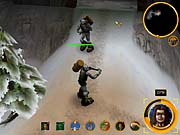
When last we tuned in to the saga of Magic & Mayhem: The Art of Magic, it was cruising toward a March 2001 ship date. Obviously that didn't come to pass, but the game is much farther along now and is beginning to look a lot like a finished product. We recently had a chance to check out a much more complete version of the game, which included the entire single-player campaign, multiplayer and skirmish modes, and a really slick musical score (a feature noticeably lacking the first time we previewed the game). The Art of Magic is still a bit rough around the edges, but it appears to be very solid in its current form, and it is clearly shaping up into an impressive genre-bending title.
The Art of Magic provides a full story-driven single-player campaign, as well as a nifty multiplayer skirmish mode. As in the first game, the single-player campaign follows a "find the lost loved one" theme. In the original Magic & Mayhem, you were an apprentice mage who had to track down a missing uncle. In The Art of Magic, you play a magic-imbued youth who must find his abducted and equally gifted sister.
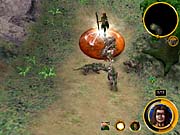
The game's single-player structure has a bit of an Evil Islands feel to it, though the star of the show is nowhere near as annoying in The Art of Magic. The main character--a young man named Aurax--wakes with a slight hangover after a huge party. He has apparently become a man, at least in his village's eyes, and the party was in celebration of this fact. But in no time at all, skeletons attack his village, kill his father, and--with the help of a powerful evil wizard--abduct his sister. However, she has time before the attack to inform Aurax that they both have the ability to wield magic powers.
As the branching campaign unfolds, Aurax will have to tackle approximately 30 missions as he attempts to find the evil wizard who kidnapped his sister. And while the original game featured very little in the way of mission variety, The Art of Magic has a decent mix of mission types. Most of the missions have the same basic goals--kill the magic user on the far side of the map--but the tactics required to complete each mission vary pretty widely. For example, one of the early missions--which is very reminiscent of the classic "Pathfinder Dwarf" level in Myth II--requires you to infiltrate a troll stronghold without being identified. You can do so by casting a morph spell that makes you look like one of the trolls. Another mission challenges you to defend several key strategic points from attack, while others simply pit you against an evil spellcaster and require that you be the last man standing. The slight variations in style and theme are a welcome change from the first game.
A Major Face-Lift
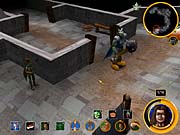
Another welcome change, and clearly the most important new feature in The Art of Magic, is the 3D graphics engine. While the original Magic & Mayhem was an isometric 2D game, the sequel is a fairly impressive fully 3D affair. Now, no one is going to faint over the visuals in The Art of Magic, but the game does a decent job with a slightly less-than-cutting-edge engine. The terrain in most areas is nicely uneven, with good accents like detailed trees, village huts, bridges, and so on. Fire deforms the landscape, slowly torching creatures, trees, and any other flammable objects in its path. Water is a key feature in some areas of the game, as you can only cross rivers at specific points.
Spell effects are the new engine's strongest point, and, generally speaking, the developers at Climax have much to be proud of where The Art of Magic's spell animations are concerned. Aside from the glowing goodness of the simple fireball spell, you'll be treated to a killer meteor storm effect--one that really conveys the impact and power of something like that actually happening--and a truly sweet lightning strike. And these are just some of the game's lesser spells. The effects tend to get better as you acquire bigger and more powerful magic.
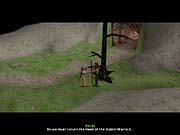
Good looks are just a secondary benefit of the new 3D engine, however. The most important gameplay enhancement resulting from the 3D engine is the ability for players to scroll around the battlefield faster, better, and with much more control. Veterans of Myth: The Fallen Lords or even Black & White will have little difficulty adjusting to the game's camera controls, which allow you to scroll with simple mouse "pushes" at the screen edges. You can also rotate and zoom in and out. The zoom controls add a slight tilt as well, so the camera angles up as you zoom out farther and farther.
One of the game's oddities is the use of completely opaque elements in the scenery. Building roofs, treetops, and even mountainsides obscure your view no matter how far you zoom in, so you have to toggle them off when you enter any covered landscape. And while the single-click toggle control is handy, it didn't take long for us to wonder why they didn't use some sort of adaptive transparency effect instead. Or, quite simply, ditch the decorative obstructions entirely, since there does not appear to be any time during the game when these elements actually add to the gameplay.
Still, the graphics are rather good throughout the game and the cutscenes, which are rendered with the game engine and are a big step up from the text-driven segments from the original Magic & Mayhem. One possible fix between now and the game's release would be an adjustment to the camera angles used at the start of most missions. Almost invariably, your character enters a mission facing the "big" part of the map. This means that your view of the world is limited to the few feet behind Aurax, while the rest of the map lies off the screen. Most of the time this isn't an issue, but occasionally you're attacked quickly and it would be nice to see those attacks coming a tad sooner.
Other Observations

The Art of Magic's spellcasting system has been well documented by now, though the flexibility of the portmanteau cannot be overstated. The portmanteau is your spell-mixing interface, and it is only available between missions. On it, you must assign your spell ingredients to magic talismans aligned with the powers of chaos, law, or neutrality. Depending upon which alignment you choose, the spell ingredient will produce a different spell. So while fly agarric mushrooms enable you to summon centaurs under law, they provide the ability to cast the morph spell when used with a neutral talisman. This magic system is quite cool, and it adds a degree of strategy to each mission's "pregame" preparations.
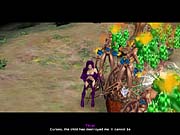
Another very cool feature in the game is the multiplayer mode. Multiplayer skirmishes in The Art of Magic are similar to the free-form melees in Myth: The Fallen Lords. Players basically select a wizard from the game's cast of characters and then choose the starting mana amount, experience level, and number of talismans for each participant. Players then have a preset amount of time to configure their portmanteaus before the melee ensues. The combat itself is more like an army-level deathmatch than a strategy game, though there are strategic points to be captured and held. Power-ups dot the landscape, and each wizard has a set number of respawns before he or she is eliminated. It's quite addictive and should prove popular on the Net once the game ships.
Among the not-so-great elements still evident in the game are a frustrating point-and-click navigation system and some iffy triggered behavior that appears to have some flaws. Moving around the gameworld is not terribly difficult--until you enter an area filled with other creatures. Since the game uses a smart cursor that changes your action based on where you click, you can often find yourself attacking a troll when what you really wanted to do is walk to the teleporter just past said troll. There may be no easy fix for this problem, but the game's relatively slow camera controls don't help much.
As far as the triggered actions go, it seems pretty clear that the missions rely heavily on scripted and triggered events. And while we never ran into any issues where events failed to trigger properly, we did see a few that triggered prematurely. For example, during a mission where Aurax must protect the earth goddess' sacred totems, we accidentally destroyed two of them and set fire to half of the goddess' treelike warriors. Despite this--and the subsequent loss of the remaining totems--Aurax somehow was rewarded with a hearty thank you and "mission accomplished" from the earth goddess herself. Apparently, random acts of arson are OK so long as the evil wizard dies somewhere, somehow.
Overall, though, The Art of Magic seems like a very solid game. The code appears to be in good shape at this stage, the graphics are quite nice, and the magic and mission systems are apparently intact. The game is now scheduled for an October ship date, and based on what we saw in this beta, it should be right on track for that time frame.
Got a news tip or want to contact us directly? Email news@gamespot.com
Join the conversation